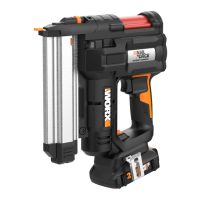3
EN
20V Cordless 18 gauge Nail/Staple Gun
4) Power tool use and care
a) Do not force the power tool. Use the correct
power tool for your application. The correct
power tool will do the job better and safer at the
rate for which it was designed.
b) Do not use the power tool if the switch
does not turn it on and off. Any power tool
that cannot be controlled with the switch is
dangerous and must be repaired.
c) Disconnect the plug from the power source
and/or the battery pack from the power tool
before making any adjustments, changing
accessories, or storing power tools. Such
preventive safety measures reduce the risk of
starting the power tool accidentally.
d) Store idle power tools out of the reach of
children and do not allow persons unfamiliar
with the power tool or these instructions
to operate the power tool. Power tools are
dangerous in the hands of untrained users.
e) Maintain power tools. Check for
misalignment or binding of moving parts,
breakage of parts and any other condition
that may affect the power tools operation.
If damaged, have the power tool repaired
before use. Many accidents are caused by
poorly maintained power tools.
f) Keep cutting tools sharp and clean. Properly
maintained cutting tools with sharp cutting edges
are less likely to bind and are easier to control.
g) Use the power tool, accessories and
tool bits etc., in accordance with these
instructions and in the manner intended for
the particular type of power tool, taking
into account the working conditions and the
work to be performed. Use of the power tool
for operations different from those intended could
result in a hazardous situation.
5) Battery tool use and care
a) Recharge only with the charger specified by
the manufacturer. A charger that is suitable for
one type of battery pack may create a risk of fire
when used with another battery pack.
b) Use power tools only with specifically
designated battery packs. Use of any other
battery packs may create a risk of injury and fire.
c) When battery pack is not in use, keep it
away from other metal objects, like paper
clips, coins, keys, nails, screws or other
small metal objects, that can make a
connection from one terminal to another.
Shorting the battery terminals together may
cause burns or a fire.
d) Under abusive conditions, liquid may be
ejected from the battery; avoid contact.
If contact accidentally occurs, flush with
water. If liquid contacts eyes, additionally
seek medical help. Liquid ejected from the
battery may cause irritation or burns.
6) Service
a) Have your power tool serviced by a
qualified repair person using only identical
replacement parts. This will ensure that the
safety of the power tool is maintained.
NAILER SAFETY WARNINGS
1. Always assume that the tool contains
fasteners. Careless handling of the nailer can
result in unexpected firing of fasteners and
personal injury.
2. Do not point the tool towards yourself or
anyone nearby. Unexpected triggering will
discharge the fastener causing an injury.
3. Do not actuate the tool unless the tool is
placed firmly against the workpiece. If the
tool is not in contact with the workpiece, the
fastener may be deflected away from your target.
4. Disconnect the tool from the power source
when the fastener jams in the tool. While
removing a jammed fastener, the nailer may be
accidentally activated if it is plugged in.
5. Use caution while removing a jammed
fastener. The mechanism may be under
compression and the fastener may be forcefully
discharged while attempting to free a jammed
condition.
6. Do not use this tacker for fastening
electrical cables. It is not designed for electric
cable installation and may damage the insulation
of electric cables thereby causing electric shock or
fire hazards.
SAFETY WARNINGS FOR
BATTERY PACK
a) Do not dismantle, open or shred battery
pack.
b) Do not expose battery pack to heat or fire.
Avoid storage in direct sunlight.
c) Do not short-circuit a battery pack. Do not
store battery packs haphazardly in a box or
drawer where they may short-circuit each
other or be short-circuited by other metal
objects. When battery pack is not in use, keep it
away from other metal objects, like paper clips,
coins, keys, nails, screws or other small metal
objects, that can make a connection from one
terminal to another. Shorting the battery terminals
together may cause burns or fire.
d) Do not remove battery pack from its original
packaging until required for use.
e) Do not subject battery pack to mechanical
shock.
f) In the event of battery leaking, do not allow
the liquid to come in contact with the skin
or eyes. If contact has been made, wash
the affected area with copious amounts of
water and seek medical advice.
g) Observe the plus (+) and minus (–) marks on
the battery back and equipment and ensure
correct use.
h) Do not use any battery pack which is not

